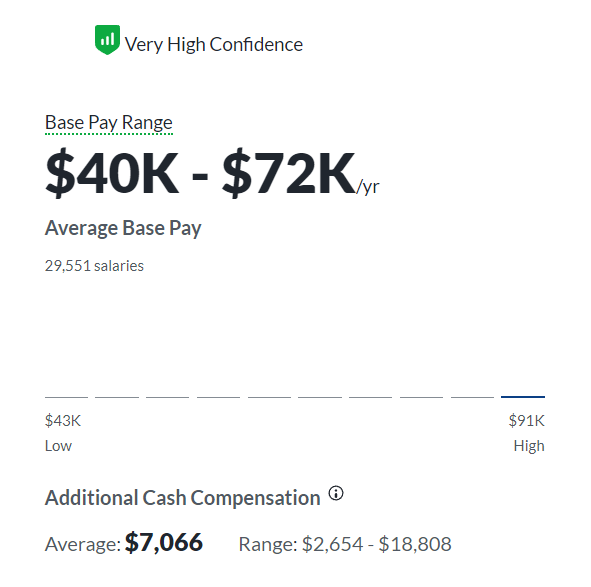Because why spend time figuring it out yourself?… I’ve compiled some of the best blogging tips to take your blog from zero to hero.
Attracting and retaining interest is challenging in a world where many voices vie for attention. This saturation can lead to frustration, leaving you wondering if success is even possible.
These tips can help bloggers, agencies, personal brands, and just about any business with a blog. And if you’re skeptical about the power of blogging, I understand.
But the proof is in the pudding.
The fact hundreds make a full-time income blogging illustrates you can drive traffic with a blog. Just look at the following numbers from Glassdoor.
Average blogger salary in Canada:

Average blogger salary in the United States:

Are you ready to take your business or personal blog to the next level?
Let’s get started.
20. Add a Favicon to Your Site
A favicon is a small icon in the browser tab that adds a professional touch to websites.

It reinforces your brand identity and adds to the user experience. The more often users see your favicon, the more likely they’ll recognize your logo in future encounters.
But your favicon doesn’t only appear on the browser tab.
It’s also displayed on the SERP (search engine results pages).

You can also find it next to each page title in a user’s browser history, bookmarks, RSS feeds, and other places.
So, how do you create one and add it to your site?
Design the Icon: Most businesses use their logo icon, but design it if you don’t have one. Place the favicon in a square format, typically 512×512 pixel canvas, to ensure clarity when scaled down.
Convert the Image: If necessary, use an online favicon generator like favicon.io to convert your image into the appropriate format. These tools often provide a set of icons suitable for various devices and contexts.
Place the Favicon on Your Website: Name your image “favicon.ico” and upload it to your site’s root directory.
Note that it may take time for Google and Bing to update your site’s appearance on the SERPs.
19. Optimize Your Monetization Strategy
The better your strategy, the more revenue potential you have. So, regularly review current strategies and test different monetization methods to maximize your revenue.
Here are some blog monetization ideas to consider.
Services: For example, personalized consulting services, content creation, travel guidance, etc.
Digital Products: Create and sell products like eBooks, online courses, and templates.
Paid Membership or Subscription Model: Offer exclusive content/services to members who pay a recurring fee.
Sell Physical Products: Good examples are branded merchandise, books, or handcrafted items.
Host Events: Organize events like retreats, workshops, or meet-ups and charge attendance fees.
Job Boards or Classifieds: Set up a job board or classifieds section and charge for listings.
Affiliate Marketing: Promote other people’s products for commission.
Advertisements: Place ads on your blog to generate revenue.
Sponsored Content: Collaborate with brands to create posts that promote their products or services. Make sure there’s alignment with your blog’s audience.
Corporate Partnerships: Partner with corporations for initiatives like content co-creation or employee training programs.
18. Refresh Older Content
This blogging tip can be more challenging than the others but vital.
Search engines favor updated content, and readers want accurate and relevant information. So, occasionally revisiting previously written posts can ensure those needs are met.
Plus, your older blog posts may have gained some authority over time. Updating them is building on existing equity rather than starting from scratch. You would also be maximizing your return on investment.
- Start by identifying posts that might contain outdated information.
- Once you have a list, systematically work through each post to update them where necessary.
- Improve the SEO of these posts. Research the current trending keywords and phrases and incorporate them into your content. Check SEO metadata and broken links, addressing any issues uncovered.
- Refresh the visuals, replacing outdated images or graphics with more high-quality ones.
- Promote your refreshed posts again. Share them on your social media, email newsletters, and other channels. Top of Form
17. Promote Your Blog Actively
This is probably the most important among all the blogging tips on this list.
Quality content needs an audience. It doesn’t matter how great your articles are if no one sees it.
Some ways to promote your blog include the following.
- Share and promote blog posts on platforms like Facebook, X, LinkedIn, and Instagram.
- Send newsletters featuring your latest blog posts.
- Write posts for blogs in your niche to tap into their audiences and establish authority. Be sure to include a link to your website somewhere.
- Partner with other bloggers or influencers for joint webinars, podcasts, or co-authored posts.
- Engage in online communities on platforms like Reddit or Quora to provide insights and subtly direct members to your content.
- Host webinars or workshops to attract an audience interested in your expertise.
- Use PR tactics like press releases to announce significant milestones and garner media attention.
- Attend industry networking events to network and promote your blog in person. Distribute materials like business cards and flyers with your blog’s URL.
- Use paid campaigns on platforms like Google Ads or Facebook to reach potential readers.
- Create and share videos related to blog topics on platforms like YouTube or TikTok. You can also make videos based on your articles.
- Start a podcast or become a guest on others.
16. Cover Competitors’ Popular Topics
You can learn much from your competitors, including what content to create and promote. After all, you share an audience; they’ve probably figured out some things that can benefit you.
- Begin by thoroughly analyzing the topics that bring significant traffic to their blogs. SEO tools like SE Rankings can help you identify high-performing content.
- Once you have this data, think about how you can approach the topics from a fresh perspective. Your goal shouldn’t be to replicate their content but to offer something distinctive – a new angle, different viewpoint, or more profound analysis.
Here are some ideas for creating better content than the competition.
- Go beyond surface-level information, providing in-depth analysis and unique insights not readily available elsewhere.
- Use imagery, videos, and interactive elements to enhance your content and make it more shareable.
- Work with an industry expert to provide unique perspectives. You can extract quotes from some of their online content if that’s not feasible.
- Use narratives to create a stronger emotional connection with the audience. This can also make complex topics more relatable and memorable.
- Use data or statistics to support your article.
- Incorporate content created by the target audience, such as reviews or forum discussions.
- Experiment with formats and structures your competitors don’t commonly use.
- Address issues your competitors didn’t cover in their content.
- Make the content downloadable in a different format, such as PDF or infographic.
15. Write Compelling Introductions
If you engage them from the start, people are likelier to stick around for the entire blog post. And the best way to do that is with your headline and introduction. I’ll cover the former in just a moment.
If you want to nail your introductions almost always, use the PAS formula.
PAS = Problem, Agitate, Solution.
- First, identify the Problem by clearly stating the issue your content will solve.
- Next, Agitate the problem by discussing its implications or highlighting the emotional and practical frustrations. The goal is to help readers recognize their experiences or challenges in your description.
- Finally, position your content as the Solution. This doesn’t mean immediately giving away all the details but instead promising a resolution.
14. Create Click-Worthy Headlines
What drew you to the last article you read? Chances are it was the headline.
A blog post’s success often hinges on its title’s strength.
Great subject lines generally have one or more of the following elements.
- Curiosity
- Urgency
- The promise of value
- Implied instant gratification
You can also create compelling titles using the ABC (Adjective, Benefit, Confidence) framework.
Adjective: Start with a powerful, descriptive word that evokes curiosity or emotion. For example, ‘effortless,’ ‘easy,’ ‘stunning,’ ‘extensive,’ etc.
Benefit: Include the key benefit your post offers. This tells your readers what they can gain or learn from the article.
Confidence: End with something that adds a sense of assurance. For example, ‘proven methods,’ ‘expert guide,’ or ‘guaranteed.’
Here’s a headline that uses the ABC formula. “Easy Weight Loss Strategies That Work For A Healthier You.”
In this headline…
Adjective: “Easy” — This suggests the weight loss strategies are easy to follow, which creates intrigue.
Benefit: “For A Healthier You” — Communicates what the reader can potentially gain from the blog post.
Confidence: “That Work” — Assures the post’s reliability in helping them achieve a healthier lifestyle.
13. Cover Popular Search Topics (current events included)
Writing about popular search topics can be a strategic way to capture interest and drive traffic to your blog. It increases the likelihood of your content being discovered since there’s already a built-in audience and could position your brand as a relevant and timely voice in the industry.
Trending topics like remote work and sustainable living or current events like AFCON (Africa Cup of Nations) are good examples. Oh, and good luck to the Nigerian Super Eagles this Sunday!
12. Establish a Niche
A well-chosen niche can help you build a highly dedicated audience. So, choosing one that balances your interests with market demand could be of benefit.
However, there’s another side to this blogging tip. Niching down might not be a good fit in cases where maintaining a broader focus is more beneficial, such as the following situations.
- If your expertise or interests span multiple areas, niching down might limit your ability to explore and share content across topics.
- In the initial stages, you might not yet fully understand where your true strengths or the most lucrative opportunities lie. A broader approach allows for experimentation with different topics to see what resonates most.
- If your analytics show consistent engagement across diverse content, niching down might alienate parts of your readership who value the variety.
- Standing out in a saturated niche is challenging. A broader focus might offer crossover opportunities and attract readers from adjacent niches.
- Markets and audience interests evolve. A broader scope allows for greater flexibility to pivot as trends change.
11. Adopt Tasteful Advertising Practices
Imagine visiting a website, and as you attempt to scroll through the content, pop-ups block your view, banner ads distract your attention, and auto-playing videos disrupt your focus.
Doesn’t sound like a good time. And to quote Sweet Brown, “Ain’t nobody got time for that.”
Effective monetization is a delicate balance between earning revenue and maintaining a positive user experience. Don’t turn your visitor’s quest for information into a frustrating ordeal.
Remember the following.
- Opt for advertisements that align with your blog’s theme to keep ads relevant.
- Ads shouldn’t be excessive and detract from the user experience.
10. Stay Compliant with Legal Requirements
Meeting legal standards can safeguard your blog against potential issues and build user trust.
Most blogs will need a transparent privacy policy outlining how they collect, use, and protect user information. A terms and conditions page (rules and guidelines for using your site) may also be required.
If you’re monetizing through affiliate marketing, include a straightforward disclosure that informs readers of your financial relationships with third-party recommendations.
Overall, your niche and region will determine every legal page necessary. So consult a qualified legal professional. You can also consider an online service for websites like Iubenda to generate your legal pages.
Other pages you might need include the following.
A Copyright Notice: Informs readers about copyright status and the legal implications of unauthorized use or reproduction.
Disclaimer: A general disclaimer page can limit liability for the information provided on your blog. This is particularly important for sites that offer advice (health, finance, legal, etc.).
Cookie Policy: This is necessary to inform users about what cookies are used for, how to control them, and how they affect the user’s experience.
DMCA Policy: For sites that host lots of user-generated content, a Digital Millennium Copyright Act (DMCA) policy can provide a process for addressing copyright infringement claims.
Accessibility Statement: This shows a website’s commitment to making its content accessible to individuals with certain health conditions or impairments. It should include the measures taken and how people can best view the content.
Comment Policy: If your blog allows comments, a comment policy page can outline the rules for participation, what types of comments are unacceptable, and how moderation is handled.
Terms of Sale: This details the conditions related to purchases if you sell products or services directly from your blog.
Children’s Privacy Policy (COPPA): If your blog collects information from children under 13, you must comply with the Children’s Online Privacy Protection Act (COPPA). This involves detailing how your business protects children’s privacy.
GDPR Compliance Statement: For blogs with European Union visitors, a General Data Protection Regulation (GDPR) compliance statement is crucial.
9. Use High-Quality Images
But “High-quality” doesn’t always mean professionally shot photos.
In some cases, authenticity and relatability take precedence over polished perfection.
For instance, a blog about cooking might find photos taken with a smartphone work best with its audience. The images offer a genuine, unfiltered glimpse into the author’s experiences.
However, most blogs will do just fine with stock imagery, and many options exist, including the following.
- Unsplash.com
- Pexels.com
- Pixabay.com
- Shopify.com/stock-photos
- Gratisography.com
- Freerangestock.com
- Morguefile.com
- Stockvault.net
- Picjumbo.com
- Negativespace.co
8. Build Your Email List
An email list lets you connect more directly and engage the audience. It’s a great way to keep visitors coming back to your blog. The challenge is getting people to sign up.
- To build your email list…
- Begin by choosing an email marketing platform like MailerLite.
- Add opt-in forms to your blog to make it easy for people to subscribe. You can also add a subscribe button or link in your navigation.
- Ensure there’s a compelling reason to sign up.
In addition, the reality is building an email list takes time. So don’t fall for the temptation of buying a list to speed things up. This can create problems.
However, it’s ok to borrow other people’s audience by collaborating or paying them to promote your offer or website. Just find other blogs you admire that share an audience with your site and pitch ideas for collaboration or offer a price to promote your content.
7. Develop an Opt-In Freebie for Email List Growth
Use enticing freebies such as eBooks, comprehensive guides, or checklists to help grow your email list. You can think of them as bonuses to incentivize new subscribers.
Here are some freebie ideas to consider.
- Interactive quizzes with personalized results.
- Template packs like social media templates, budget planners, content calendars, etc.
- Exclusive video course or webinar access.
- Access to a private community, such as a forum, Facebook group, or membership site.
6. Optimize for Searcher Intent
Modern search engine algorithms aren’t just matching keywords. They match content with the user’s underlying purpose behind each search query.
That means every article you publish should match the search intent of the target keyword.
- First, check the top-ranking pages. What are these pages offering? What type of information are they providing? What is the end goal? This will give you a picture of what users primarily want when they type in the keyword.
- Align your content with user needs. Is the intent informational (seeking knowledge) or navigational (looking for a specific website or page)? Is it transactional (ready to buy or engage) or commercial investigational (considering a purchase)? Tailor your blog posts accordingly.
- Monitor how search intent evolves and revise old content to align with current trends.
5. Focus on Quality Content Creation
Quality matters. It’s an essential aspect of motivating readers to return.
Prioritize creating well-written, informative, engaging, and well-presented blog posts. But don’t overthink it all and potentially become stuck (analysis paralysis).
Also, consider your strengths and get help where necessary. For example, you could work with an editor to proofread your work. Similarly, you can work with a copywriter to take your ideas and create the content.
4. Use A Professional, Visually Appealing Theme That Takes SEO Into Account
A great theme gives your content a better chance of performing well on search engine results and can increase return visits.
Key features to look for in a theme include the following.
Fast Loading: It should load quickly to reduce bounce rates and improve user experience. Site speed is also part of search engine user experience measurement systems.
Mobile Responsiveness: Guarantees your blog is easily accessible and navigable on various devices. This is crucial as mobile traffic surpasses desktop (Similar Web).

Clean Coding: Streamlined, error-free website structure that search engines can easily crawl and index.
Support for Schema Markup: This is a type of metadata that can improve how search engines understand, interpret, and present your content in search results. Using it strategically can also increase click-through rates from the SERP.
Browser Compatibility: Ensures your blog appears and functions consistently across all major web browsers.
Built-In Breadcrumbs: Provides a navigational aid on your blog, showing users their current location within the site’s hierarchy.
Accessibility Features: Some themes may include considerations for users with specific challenges, such as keyboard navigation and screen reader support. However, most themes are incomplete in that regard. Consider using a tool like AccessiBe for web accessibility.
3. Create a Strong Brand Identity
Use consistent logos, color schemes, and design elements.
A strong brand identity can help your blog stand out and be easily recognizable across different platforms. It helps people put an identity to the content producer.
So don’t neglect this essential aspect.
2. Invest in a Self-Hosted Website
Move away from free hosting platforms and invest in a self-hosted website. These are blogs hosted on your servers or through a third-party hosting service. And unlike free blogging platforms that are restrictive, a self-hosted blog would give you full control over the design, functionality, and monetization strategies.
Some self-hosted service options include the following.
Hostinger: They offer affordable hosting plans focusing on speed and simplicity.
Tech Help Canada: Provides various digital services to businesses, including reliable WordPress and other web hosting.
Blue Host: They are well-regarded for hosting services and excellent customer support.
HostGator: This company is known for its wide range of hosting options, flexible plans, reliability, and 24/7 customer service.
1. Secure Your Blog with an SSL/TLS Certificate
SSL/TLS helps protect your blog and keep user data secure. It encrypts data going into your website (incoming requests from users) and going out from the site (responses from your server).

It can also improve performance on search results, as it’s part of Google’s system for measuring user experience. As such, sites that switch from non-secure to secure may see a ranking boost on the SERP.
Here’s to Your Success
Following these blogging tips should elevate your blog and potential for generating revenue. But bear in mind that blogging is a continuous process that requires flexibility, a commitment to ongoing education, and the constant fine-tuning of your approach. Good luck!

I’m a freelance copywriter and SEO specialist. I aim to empower individuals and businesses with impactful marketing solutions and insights. In my downtime, I recharge by embracing the beauty of nature or cherishing moments with my loved ones. If you found value in this post, please consider sharing it.
Want a heads-up once a week whenever a new article drops?







